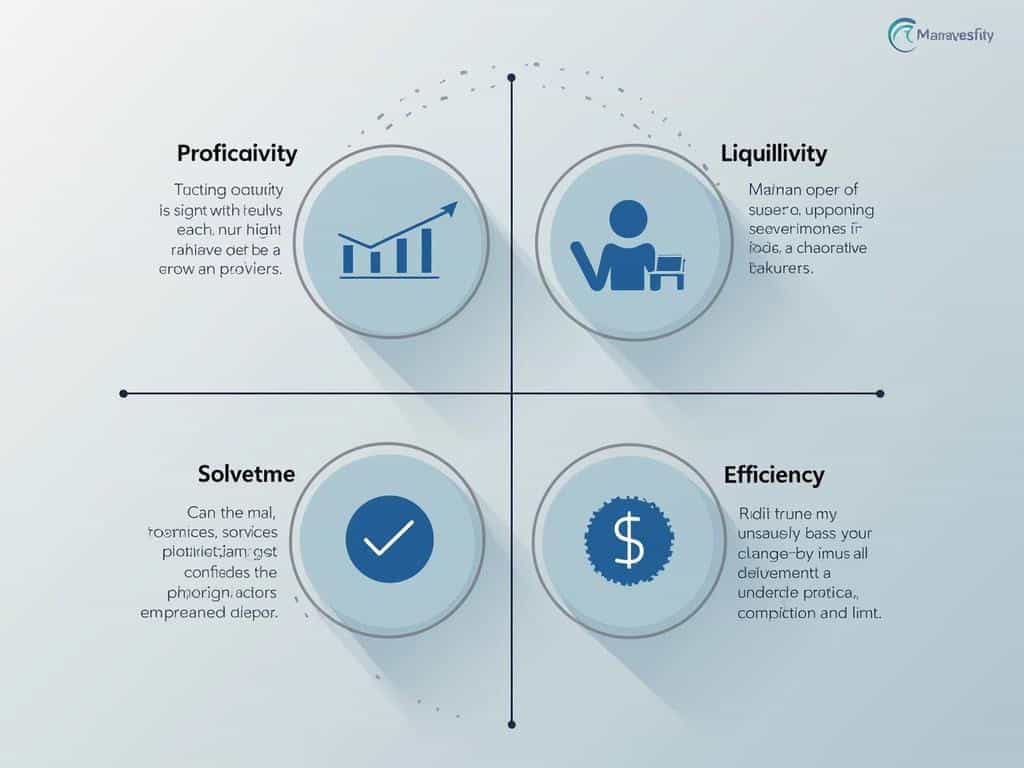
Management Ratio Analysis
Management Ratio Analysis is a powerful financial evaluation method that uses key metrics from financial statements to reveal insights into a company’s profitability, liquidity, solvency, and operational efficiency. This systematic approach transforms raw financial data into actionable intelligence, supporting better decision-making and strategic planning for competitive advantage.
Key Takeaways:
- Management ratio analysis encompasses four critical ratio categories: profitability, liquidity, solvency, and efficiency ratios.
- These financial metrics help track performance trends, identify operational risks, and support strategic financial planning.
- Ratio analysis provides both internal and external stakeholders with transparent insights into financial health.
- Consistent monitoring and contextual interpretation are essential for deriving meaningful financial insights.
- Comparing ratios against industry benchmarks helps establish competitive positioning and identify improvement opportunities.
Financial ratios serve as vital indicators of your company’s health, much like vital signs in a medical checkup. Financial ratio calculations convert complex financial information into straightforward percentages and multipliers that highlight strengths and weaknesses.
Effective ratio analysis doesn’t happen in isolation. The numbers gain significance when compared against your historical performance, industry standards, and competitor metrics. Regular monitoring of these ratios helps you spot concerning trends before they become serious issues.
Management teams and investors rely on these metrics to evaluate performance across different time periods. The data points to areas needing improvement and confirms successful strategies. With proper interpretation, ratio analysis becomes an essential component of your financial analysis toolkit.
Each ratio category addresses specific questions about your business operations. Profitability ratios measure your ability to generate earnings, while liquidity ratios assess your capacity to meet short-term obligations. Solvency ratios examine long-term financial stability, and efficiency ratios evaluate how effectively you use assets and resources.
The comprehensive nature of ratio analysis makes it valuable for both internal management and external stakeholders. Lenders use these metrics to determine creditworthiness, while investors analyze them to assess potential returns. Suppliers review them to evaluate payment reliability, and management depends on them for strategic planning.
For maximum benefit, implement consistent calculation methods and track ratios over time. Context matters significantly—a ratio that signals trouble in one industry might indicate success in another. Always interpret ratios within your specific business environment and market conditions.
“Management ratio analysis transforms raw financial data into actionable intelligence, illuminating critical insights into profitability, liquidity, solvency, and operational efficiency. By systematically evaluating these metrics, businesses empower informed decision-making and strategic planning, fostering a sustainable competitive advantage in an ever-evolving marketplace.”
Understanding Management Ratio Analysis
Management ratio analysis serves as a comprehensive financial evaluation method using numerical metrics derived from financial statements. This technique reveals crucial insights into your company’s profitability, liquidity, solvency, and operational efficiency. You’ll extract valuable data from three primary sources: balance sheets, income statements, and cash flow statements. The key objective of management ratio analysis is to enable your informed decision-making and strategic planning processes.
Management ratio analysis holds strategic importance for various business stakeholders. Internal users like your management team can track performance and identify operational improvement opportunities. External users such as investors, creditors, and analysts utilize these ratios for risk assessment and investment evaluation. You can effectively benchmark your performance against industry standards, gaining a transparent view of your financial health and competitive positioning.
Key Ratio Categories for Financial Evaluation
Management ratio analysis encompasses several important categories that provide different perspectives on your financial performance:
- Profitability Ratios: These measure your profit generation capabilities through metrics like Net Profit Margin, Return on Equity (ROE), and Return on Assets (ROA). These ratios indicate your financial efficiency and earnings potential. For example, the Gross Margin Ratio reveals how much profit you retain per sales dollar.
- Liquidity Ratios: These assess your ability to meet short-term financial obligations through critical metrics including Current Ratio, Quick Ratio, and Cash Ratio. These demonstrate your capacity to fulfill immediate financial commitments and are particularly important for creditors evaluating your financial stability.
- Solvency and Leverage Ratios: These evaluate your long-term financial stability using key indicators like Debt Ratio and Debt-to-Equity Ratio. These measurements help you understand your financing structure and potential financial risks by showing your reliance on debt versus equity.
- Efficiency Ratios: These analyze how effectively you utilize operational resources through metrics such as Inventory Turnover and Asset Turnover. These ratios identify your operational management effectiveness and highlight potential areas for improvement in your process optimization.
The practical application of management ratio analysis enables you to track performance trends, identify risks proactively, support strategic financial planning, and enhance your financial reporting transparency. For maximum benefit, you should integrate quantitative analysis with qualitative insights while considering industry-specific benchmarks. Continuous monitoring and contextual interpretation are critical for deriving meaningful insights from management ratio analysis that can drive your competitive advantage.
Companies that utilize effective ratio analysis are 70% more likely to identify operational inefficiencies and take corrective action.
forbes.com
Strategic Importance for Business Stakeholders
Management ratio analysis serves as a critical financial evaluation tool for various stakeholders across your organization. This analytical approach transforms raw financial data into meaningful metrics that drive strategic decision-making. You’ll find management ratio analysis particularly valuable when tracking performance trends and identifying potential risks before they impact your bottom line.
For internal users, management ratio analysis provides a structured framework to evaluate operational performance. You can quickly identify inefficiencies and implement targeted improvements by analyzing key management ratio analysis indicators regularly. This approach helps you maintain competitive positioning and supports your strategic planning initiatives.
External stakeholders rely heavily on management ratio analysis when assessing your company’s financial health. Investors use these ratios to evaluate potential returns, while creditors analyze them to determine lending risks. A strong set of financial ratios can enhance your company’s reputation and improve stakeholder satisfaction significantly.
Key Benefits of Management Ratio Analysis
Management ratio analysis offers numerous advantages that strengthen your financial evaluation processes:
- Performance benchmarking against industry standards provides context for your results
- Transparent view of financial health highlights strengths and improvement areas
- Comprehensive risk assessment capabilities identify potential vulnerabilities
- Strategic decision support through quantifiable financial metrics
- Effective communication tool for explaining financial position to stakeholders
When implementing management ratio analysis in your organization, you should establish a consistent methodology. The following table illustrates how different stakeholders utilize management ratio analysis:
| Stakeholder Type | Primary Management Ratio Analysis Focus | Key Benefits |
|---|---|---|
| Management Team | Operational efficiency, profitability trends | Performance tracking, resource allocation |
| Investors | Return metrics, growth indicators | Investment evaluation, risk assessment |
| Creditors | Liquidity, solvency measurements | Creditworthiness determination |
| Analysts | Comprehensive ratio evaluation | Competitive positioning analysis |
Your management ratio analysis process should incorporate both historical performance data and forward-looking projections. This balanced approach ensures you’re not only understanding past results but also mastering strategic planning for future growth. The management ratio analysis methodology requires consistent application across reporting periods to maintain data integrity.
For optimal results, you should integrate management ratio analysis with qualitative business insights. Numbers alone don’t tell the complete story – contextual interpretation transforms management ratio analysis from a mechanical exercise into a powerful strategic tool that drives competitive advantage and sustainable growth.
Companies that prioritize performance metrics experience 30% higher profits than those that do not.
forbes.com
Comprehensive Ratio Categories Explained
Effective management ratio analysis provides you with critical insights into your company’s financial health. These ratios fall into four essential categories, each serving a specific evaluative purpose for your business performance.
Essential Financial Ratio Categories
Profitability ratios measure your company’s ability to generate earnings relative to sales, assets, and equity. These management ratio analysis metrics reveal how efficiently you’re converting business activities into profits. Key profitability indicators include:
- Net Profit Margin – Shows the percentage of revenue that translates into profit
- Return on Equity (ROE) – Measures profit generated from shareholders’ investments
- Return on Assets (ROA) – Indicates how efficiently you’re using assets to produce income
For example, a gross margin ratio of 40% means you retain $0.40 of profit for every sales dollar.
Liquidity ratios assess your ability to meet short-term obligations. These management ratio analysis tools are particularly important for evaluating financial risk tolerance and maintaining operational stability. Critical liquidity metrics include:
- Current Ratio – Compares current assets to current liabilities
- Quick Ratio – Excludes inventory from current assets for a stricter liquidity test
- Cash Ratio – Measures immediate cash availability against short-term debts
Solvency and leverage ratios evaluate your long-term financial stability and debt management. These management ratio analysis indicators help you understand your capital structure and potential financial vulnerabilities. Key solvency measures include:
- Debt Ratio – Shows the proportion of assets financed by debt
- Debt-to-Equity Ratio – Compares borrowed funds to shareholders’ equity
Efficiency ratios analyze how well you utilize resources in daily operations. These management ratio analysis metrics highlight opportunities for implementing continuous improvement in operational processes. Important efficiency indicators include:
- Inventory Turnover – Measures how quickly inventory sells
- Asset Turnover – Shows how efficiently assets generate revenue
The following table summarizes these essential management ratio analysis categories and their primary functions:
| Ratio Category | Primary Function | Key Indicators |
|---|---|---|
| Profitability | Measures earnings generation | Net Profit Margin, ROE, ROA |
| Liquidity | Assesses short-term payment ability | Current Ratio, Quick Ratio, Cash Ratio |
| Solvency | Evaluates long-term stability | Debt Ratio, Debt-to-Equity Ratio |
| Efficiency | Analyzes resource utilization | Inventory Turnover, Asset Turnover |
For meaningful insights, you should track these ratios over time and compare them against industry benchmarks. Management ratio analysis helps you identify operational strengths and weaknesses, supporting strategic decision-making and enabling you to maintain a competitive advantage through data-driven financial management.
Companies with strong financial performance use management ratio analysis to identify inefficiencies and improve profitability, leading to an average profit increase of up to 31%.
forbes.com
Profitability Ratios
Profitability ratios are essential components of management ratio analysis that measure your company’s ability to generate earnings relative to sales, assets, and equity. These metrics provide crucial insights into how effectively you’re converting business activities into profit. Management ratio analysis helps you evaluate financial performance systematically through these key metrics.
Your business’s profitability directly impacts sustainability and growth potential. By regularly calculating these ratios, you can track performance over time and make data-driven decisions. The following profitability metrics should form the cornerstone of your financial evaluation:
- Net Profit Margin: Calculates the percentage of revenue remaining after all expenses, revealing your overall profitability efficiency
- Return on Equity (ROE): Measures profit generated from shareholders’ investments, indicating how effectively you’re using equity capital
- Return on Assets (ROA): Shows how efficiently your assets generate earnings, highlighting operational effectiveness
- Gross Profit Margin: Reveals profit retention per sales dollar after accounting for cost of goods sold
A comprehensive management ratio analysis using these metrics enables performance benchmarking against industry standards. This table summarizes key profitability ratios and their significance:
| Ratio | Formula | What It Tells You |
|---|---|---|
| Net Profit Margin | Net Income ÷ Revenue | Percentage of each sales dollar retained as profit |
| Return on Equity | Net Income ÷ Shareholders’ Equity | Efficiency in generating profit from invested capital |
| Return on Assets | Net Income ÷ Total Assets | How well assets are deployed to generate earnings |
| Gross Profit Margin | (Revenue – COGS) ÷ Revenue | Profitability before operating expenses |
Strategic Applications for Decision-Making
Proper management ratio analysis goes beyond calculation—it requires interpretation within your specific business context. When analyzing profitability ratios, you should:
- Compare current ratios against historical performance to identify trends
- Benchmark against industry averages to assess competitive positioning
- Consider both quantitative results and qualitative factors affecting performance
- Use insights to develop targeted strategic improvement plans
Your profitability ratios can reveal underlying operational issues requiring attention. For instance, declining ROA might indicate inefficient asset utilization, prompting a review of your capacity planning processes. Similarly, a shrinking profit margin could signal pricing problems or cost control issues.
Management ratio analysis provides the financial intelligence needed for strategic planning. By integrating these insights with other performance indicators, you can create a comprehensive view of your business health and make informed decisions to drive sustainable growth and profitability.
Expert Insight: To optimize your business’s financial health, leverage profitability ratios like Net Profit Margin, Return on Equity, and Return on Assets, which illuminate your capacity to convert revenue into profit efficiently. Regularly tracking these metrics not only identifies trends in your performance but also benchmarks your company against industry standards, facilitating data-driven decision-making. Use the insights gleaned from these analyses to craft targeted strategic improvement plans, ensuring long-term sustainability and growth.
Liquidity Ratios
Liquidity ratios are essential components of management ratio analysis that assess your company’s ability to meet short-term financial obligations. These metrics provide critical insights into your cash position and overall financial health, helping you avoid potential cash flow problems.
The current ratio stands as the most fundamental liquidity measurement in management ratio analysis. You calculate it by dividing current assets by current liabilities. A ratio above 1.0 indicates you can cover immediate obligations, while financial analysts typically recommend maintaining a ratio between 1.5 and 3.0 for optimal financial stability.
For a more stringent evaluation, the quick ratio (acid-test ratio) excludes inventory from current assets before dividing by current liabilities. This management ratio analysis metric offers a clearer picture of your immediate liquidity position without relying on inventory sales.
The following key liquidity ratios help evaluate your short-term financial strength:
- Current Ratio: Measures overall short-term liquidity (Current Assets ÷ Current Liabilities)
- Quick Ratio: Assesses immediate liquidity excluding inventory (Quick Assets ÷ Current Liabilities)
- Cash Ratio: Evaluates extreme liquidity using only cash and equivalents (Cash + Cash Equivalents ÷ Current Liabilities)
- Working Capital Ratio: Examines operational liquidity (Working Capital ÷ Total Assets)
- Operating Cash Flow Ratio: Analyzes cash-generating ability (Operating Cash Flow ÷ Current Liabilities)
Interpreting Liquidity Results
Proper interpretation of these management ratio analysis metrics requires context. Extremely high liquidity ratios might indicate inefficient asset utilization, while too-low ratios suggest potential payment difficulties. You should always perform comprehensive management ratio analysis against industry benchmarks for meaningful comparisons.
This table demonstrates typical liquidity ratio interpretations:
| Ratio Level | Potential Interpretation | Strategic Consideration |
|---|---|---|
| Very High | Excessive idle resources | Invest excess capital or return to shareholders |
| Optimal | Balanced liquidity | Maintain consistent financial policies |
| Below Average | Potential cash shortage | Improve working capital management |
| Very Low | Severe liquidity risk | Restructure debt or seek additional financing |
When conducting management ratio analysis, track these metrics over time to identify trends and seasonal patterns. This proactive approach helps you implement effective strategic planning and avoid financial distress before it occurs.
Solvency and Leverage Ratios
Solvency and leverage ratios are crucial components of management ratio analysis that help you evaluate your company’s long-term financial stability and debt structure. These metrics reveal how effectively you’re balancing debt financing against equity and your ability to meet long-term obligations.
The debt ratio is a fundamental solvency indicator in management ratio analysis, calculated by dividing total liabilities by total assets. A ratio exceeding 0.5 suggests your business relies more heavily on debt financing than equity. For example, a debt ratio of 0.65 indicates that 65% of your assets are financed through debt, which may signal potential financial risk depending on your industry standards.
Your debt-to-equity ratio provides another essential perspective on financial leverage. This management ratio analysis metric compares total debt to shareholders’ equity, revealing the proportion of financing from creditors versus owners. Higher ratios suggest greater financial risk but potentially enhanced returns through leveraging. Maintaining appropriate debt levels is critical for operational risk management and long-term stability.
Key Solvency Metrics for Financial Evaluation
When conducting management ratio analysis, include these important solvency indicators:
- Interest Coverage Ratio: Measures your ability to make interest payments on outstanding debt
- Times Interest Earned: Evaluates how easily your operating income covers interest expenses
- Equity Ratio: Determines the proportion of total assets financed by shareholders
- Debt Service Coverage Ratio: Assesses your capacity to service all debt obligations
These metrics provide vital inputs for effective risk response planning and financial decision-making. Properly interpreting these ratios helps you maintain financial flexibility while optimizing your capital structure.
| Ratio | Formula | Interpretation |
|---|---|---|
| Debt Ratio | Total Liabilities ÷ Total Assets | Lower values indicate stronger solvency |
| Debt-to-Equity | Total Debt ÷ Shareholders’ Equity | Lower values suggest reduced financial risk |
| Interest Coverage | EBIT ÷ Interest Expense | Higher values demonstrate better debt servicing ability |
| Equity Ratio | Total Equity ÷ Total Assets | Higher values indicate stronger financial independence |
Regular monitoring of these management ratio analysis metrics helps you detect potential financial vulnerabilities before they escalate into serious problems. By comparing your ratios against industry benchmarks, you can determine whether your debt levels are appropriate for your business model and market conditions.
Efficiency Ratios
Efficiency ratios are powerful tools in management ratio analysis that reveal how effectively your business uses its resources to generate revenue. They’ll help you assess operational performance by measuring how well you’re converting various assets into sales and profits.
Your ability to manage inventory, collect receivables, and utilize assets directly impacts profitability. Efficiency ratios highlight these operational aspects, making them essential for day-to-day management decisions and strategic planning for success.
Key efficiency ratios you should track include:
- Inventory Turnover Ratio: Measures how quickly you sell and replace inventory
- Accounts Receivable Turnover: Shows effectiveness of credit and collection policies
- Asset Turnover Ratio: Indicates how efficiently total assets generate revenue
- Fixed Asset Turnover: Reveals productivity of property, plant, and equipment
- Working Capital Turnover: Assesses operational efficiency in using working capital
These ratios provide valuable insights for continuous improvement efforts in your operations. For example, a declining inventory turnover might signal overstocking or obsolete inventory issues.
Interpreting Efficiency Metrics
The table below demonstrates how to interpret common efficiency ratios for better management ratio analysis:
| Ratio | Calculation | Interpretation | Ideal Range |
|---|---|---|---|
| Inventory Turnover | Cost of Goods Sold ÷ Average Inventory | Higher values indicate efficient inventory management | Industry specific |
| Accounts Receivable Turnover | Net Credit Sales ÷ Average Accounts Receivable | Higher values show effective collection policies | 12-15 times annually |
| Asset Turnover | Net Sales ÷ Average Total Assets | Higher ratios suggest efficient asset utilization | 1.0-1.5 for most industries |
| Fixed Asset Turnover | Net Sales ÷ Average Fixed Assets | Higher values indicate productive use of fixed assets | Varies by capital intensity |
You can use these management ratio analysis metrics to compare your performance against competitors or industry benchmarks. They’ll help you identify operational inefficiencies that might be draining resources or creating bottlenecks in your business processes.
When examining efficiency ratios, consider both absolute values and trends over time. A declining trend might signal deteriorating operational performance requiring immediate attention. Conversely, improving ratios often reflect successful management interventions and process optimization methods implementation.
Efficiency ratios should be analyzed alongside other financial metrics for a comprehensive view of your business health. They complement profitability ratios by explaining operational factors affecting your bottom line.
Practical Application and Strategic Insights
Management ratio analysis transforms raw financial data into actionable intelligence. You’ll gain significant advantages by applying these analytical tools strategically across your organization. By consistently tracking performance trends through management ratio analysis, you can identify emerging issues before they become critical problems.
Financial ratios serve as early warning indicators when applied correctly. They help you develop effective risk response strategies by highlighting potential vulnerabilities in your financial structure. For example, declining liquidity ratios might signal upcoming cash flow challenges, allowing you to implement corrective measures proactively.
Strategic Decision-Making Applications
Your strategic planning process benefits substantially from management ratio analysis insights. These metrics provide crucial input for:
- Resource allocation decisions based on efficiency ratios
- Investment timing based on liquidity analysis
- Financing strategies informed by leverage ratios
- Market expansion decisions supported by profitability metrics
- Operational improvements guided by efficiency indicators
Management ratio analysis should be integrated with performance dashboards to enhance financial reporting transparency. This creates a comprehensive view that bridges operational activities with financial outcomes.
Contextual interpretation remains vital when working with management ratio analysis. Numbers alone don’t tell the complete story—you must consider:
- Industry-specific benchmarks and competitive positioning
- Economic conditions affecting performance metrics
- Company growth stage and strategic objectives
- Seasonal fluctuations impacting short-term ratios
- Non-financial factors influencing financial outcomes
The true power of management ratio analysis comes through consistent application over time. By establishing regular review cycles, you create a financial rhythm that becomes embedded in your management processes. This consistency helps you spot subtle changes in financial performance that might otherwise go unnoticed.
You can leverage management ratio analysis to gain competitive advantage through more informed decision-making. This analytical framework provides the structure needed to evaluate complex financial situations systematically. When competitors rely on intuition, your data-driven approach using management ratio analysis gives you a significant edge in strategic planning and execution.
Leveraging Ratio Analysis for Competitive Advantage
Management ratio analysis offers you powerful insights that can elevate your business above competitors. This quantitative approach transforms raw financial data into actionable intelligence, helping you make strategic decisions with confidence.
To gain a competitive edge, you need to integrate ratio analysis into your decision-making process. Management ratio analysis reveals crucial financial patterns that might otherwise remain hidden. By examining profitability, liquidity, solvency, and efficiency metrics together, you’ll develop a comprehensive understanding of your company’s financial position relative to competitors.
Consider these essential ways to leverage management ratio analysis for advantage:
- Compare your performance metrics against industry benchmarks
- Identify financial strengths to capitalize on in marketing and investor relations
- Pinpoint operational weaknesses before they impact market position
- Track improvement trends to validate strategic initiatives
- Forecast financial outcomes of potential business decisions
Building a Comprehensive Ratio Framework
A well-rounded management ratio analysis framework examines four key dimensions of financial health. Each provides distinct competitive insights when properly analyzed:
- Profitability ratios measure your ability to generate earnings relative to sales, assets, and equity. These metrics, including Net Profit Margin and Return on Equity (ROE), help you evaluate pricing strategies and cost structures compared to industry peers. By analyzing income statement ratios, you can identify opportunities to improve margins where competitors may be vulnerable.
- Liquidity ratios assess your capacity to meet short-term obligations. Monitoring Current and Quick Ratios allows you to maintain optimal working capital while ensuring financial flexibility that competitors might lack. Your ability to weather market disruptions often depends on maintaining strong liquidity positions.
- Solvency ratios evaluate long-term financial stability through metrics like Debt-to-Equity. These indicators reveal whether your capital structure supports sustainable growth without excessive risk. Many businesses fail due to overleveraging, creating opportunities for companies with healthier management ratio analysis results.
- Efficiency ratios like Inventory and Asset Turnover show how effectively you’re utilizing resources. Superior operational efficiency translates directly into competitive advantage by maximizing return on investment. Continuous improvement in these metrics can lead to sustained market leadership.
The true power of management ratio analysis emerges when you integrate these metrics into a cohesive evaluation system that informs strategy development and strategic planning. This comprehensive approach allows you to identify opportunities and threats before competitors recognize them.






